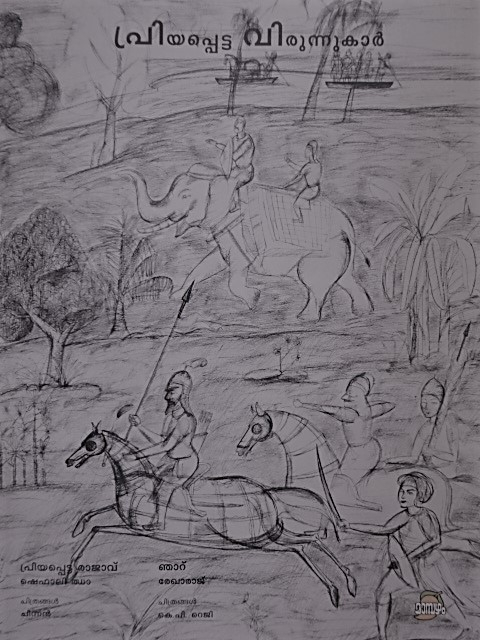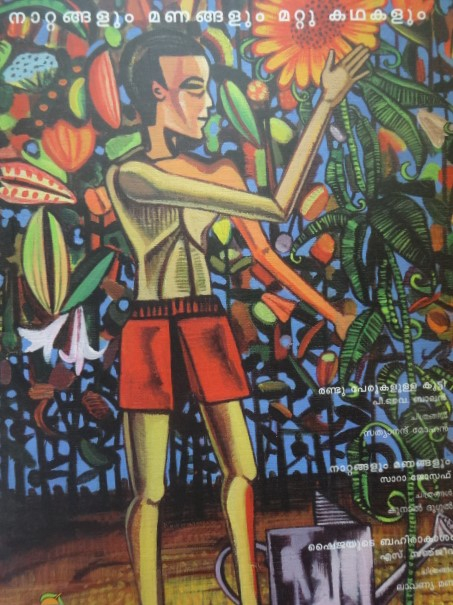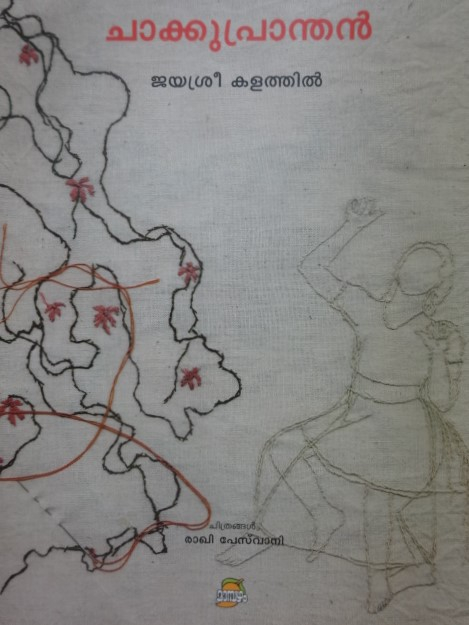Ammayennammakum achanennachanum
Perennu kunjimon othidumbol
Artham athinetrayennarinjeeduvan
Pusthakajnaniyam njan ashakthan.[i]
Mother’s name “mother,” father’s name “father,”
Mouths the dear young boy
Though erudite, I have no measure
Of its meanings manifold.
Kunjunni’s—renowned (children’s) poet in Malayalam—above lines, in his usual inimitable simplicity, throw light on the complexity of a child’s world, which often escapes adult perception. There have been many attempts at understanding and defining the child’s world and childhood, in particular. Most often, these definitions have resulted in the construction of a homogenous notion of child and childhood with universal experiences. Children’s literature and curricula for children often draw upon and are designed in accordance with such insights. But, maybe inescapably, most of such insights are based on the childhood experiences, or memories thereof, of adult writers.
I do not make a claim to any exception, though this article is an attempt to engage with ‘different’ tales that represent ‘alternate’[ii] childhoods, in which many a times child is the narrator but still not the ‘author’. Nevertheless, these ‘different’ tales, arguably, subvert the normative representations of childhoods in children’s literature of Kerala. In this article, childhood is understood as a category of analysis that interrogates 1) the binary of child/adult, 2) the plurality of childhoods located in experiential categories such as religion, caste, gender, class, sexual orientation, skin colour and race, and 3) under/mis/representations of childhood in children’s literature. Children’s literature as a genre is canonically governed by the power relation between ‘adult writers’ and ‘child readers’, in which the former always writes for/about the latter; whereas an interrogative children’s text arguably aims at re-defining the power relation between adult-writers and child-readers. In these texts, readers are constantly reminded that what is desirable and undesirable are culturally and socially constructed; they are provoked to question and subvert a variety of ideologies and structures of authority; characters are made to speak or behave in a manner oppositional to normal socializing expectations; child-readers are exhorted to recognize that adult authority is often arbitrary.[iii]
Different Tales—a series of eight books that Anveshi Research Centre teamed with DC Books had brought out in 2008 in English, Malayalam and Telugu—is one such venture.[iv] (Fig. 1) It has stories from Telugu, Malayalam and English children’s literature which are translated and produced simultaneously in all these three languages. These are texts that are interrogative in nature. The publishers described it as,
Tales that unearth stories from regional languages: stories that talk about the life-worlds of children in communities that one rarely reads about in children’s books. Many of the stories draw on the writers’ own childhoods to depict different ways of growing up in an often hostile world, finding new relationships with peers, parents and other adults (Blurb, Different Tales).
In a nutshell, Saheer, a Muslim boy[v] exclaims that in school, ‘all those whom he loved and who loved him were lost. Even the worlds that were familiar to him felt distant in school’; he implores that ‘why don’t they have these songs and stories (here the reference is to Nafeesat ballad, stories of Mohiuddin Sheikh, of the battle of Badar, of Aliyar Thangal, the love story of Badarul Muneer and Husnul Jamal, etc.) in school textbooks’? He retorts that ‘nowhere in this text is there a Muslim name’ and adds Rasheed as a character in one of the textbook stories. (Fig. 2) Adil,[vi] who is haunted by his teacher’s bewildering ‘look’ in the history class while teaching the battle between the Rajput King Rana Sanga and Emperor Babar, bursts out, ‘History doesn’t like me’.[vii] In all these texts, the child narrator is raising pertinent questions about the ‘epistemic violence’ inflicted by the colonial and nationalist discourses through pedagogy. The incident cannot be read in isolation as it refers to the experiences of a Muslim child in the modern egalitarian space of school, who is often forced to become representative of the ‘threats’ to the emerging Indian nation. While, at one level, these stories critique the under- and mis-representations of minorities and marginalized communities in the mainstream nationalist and colonial histories, as experienced by children belonging to these communities, it simultaneously reworks the ‘passive’ equation between such essentialised texts and its ‘minor’ readers, as the children in the stories rewrite these narratives as ‘histories from below’.
When Mathai’s[viii] dead ancestors prepare the field for him and return to the burial ground at night; when Adil [ix] meets Emperor Babar who narrates a ‘different’ version of the battle at Khanua, in which Muslims are not ‘demons’; when Shaija[x] dreams of living in a space which would take away all their predicaments; the generic line between ‘fantasy’ and ‘realism’ that children’s literature has sacredly upheld blurs. (Fig. 3) Mathai, who is a Christian, represents the ‘minor’ communities that historically did not have access to land, and who were deprived of resources even after the Land Distribution Bill provided them with ownership of land. Again, Adil belongs to those communities that had to forcefully bear the guilt of being communal, anti-national and ‘fanatic’. Thus, when dead ancestors plough the field for Mathai, or when the dead Babar visits and narrates ‘history’ to Adil, and when Shaija dreams of Space, it is not merely a ‘fantasy’, but an experimentation to reinterpret given textualities. Memory, dream etc., here, become textual tropes located in one’s world views that stem from their life world, which deconstruct and reconstruct ‘historical’ conditions.

Sreelatha and Suvarna,[xi] from two different castes, realize that ‘friendship is only in school, not in our village’ and that learning letters and alphabets do not erase ‘the difference between high and low’. Annie and other children from Kokanchira,[xii] realise that their world ‘smells different at different times. Sometimes, of garlic. Sometimes, of washing soda. Sometimes of rusting metal. Sometimes of naphthalene balls. Of fish…’. They take ‘deeeeeeep’ breath to smell the scents of their teachers, and recognize that smell marks their ‘difference’. Balachandran/Freetus[xiii] fights the trauma of bearing two names—Balachandran in school and Freetus in the seminary—which locates him in the equation ‘Balachandran-Freetus-Convert-Milk-Powder-Christian’. (Fig. 4) In all these narratives, these ‘conscripts of modernity’[xiv] rip apart and expose the secular modern spatiality of school and the utopic egalitarian life that ‘modern’ education promises. School as a space and pedagogy as an instrument have reaffirmed caste, religious, tribal, gender hierarchies and hegemonic practices and has ‘historically’ excluded and ‘othered’ children from the ‘minor’ communities. The abstract universal category called ‘child’, who has transcended the particularities of their belongingness, that modern ideological state apparatuses like school–pedagogy–education have constructed, is then concretised in ‘its’ entrenched particularities of religion/caste/class/gender/tribe (and sexuality which still does not configure) through these stories.

When Khadeer[xv] elaborates the cooking of mouth-watering head curry at his home every Sunday, in which a whole community plays different roles; when Kancha Ilaiah ‘holds a pen to (his mother’s) own story’, in whose world ‘Baindlas would sing for all/ Mandichulas and soothsayers told stories of all/ … Garadis performed…/ Gangireddulas made the bulls dance/ Sarthakandly played community tunes…’; there is a celebration of heterogeneous sensorial experiences of different childhoods in different communities—of taste, of smell, of sound, sight and touch. These stories talk back to the stories in which Onam and Onasadya (Onam feast) are the only festival and taste that finds a place. They stand out in a social world where ‘distinctions’ of taste—hierarchized by social, cultural and economic capital—forms the basis of ‘symbolic violence’ and social judgement.[xvi] They reflect upon the sensorial experiences of ‘minor’ communities which have always been marginalized as ‘yet-to-be-modernised’ tastes. When Ilaiah’s mother dragged him to school and told the school to ‘admit him’, who when asked ‘when was he born’ retorted that ‘before the great fire / the day I planted the seeds / after the rains began / and returned at dusk / I gave birth to him’, it is also an invitation to the ‘different’ temporalities, not strictly within the modern calendric and historical time frame, in which people live. Hence it is also a critique of the modernity project that keeps communities in the waiting room of a linear history by categorizing them as ‘not yet’ modern.[xvii]
The texts adopt a ‘bibliotherapic’[xviii] modality when a Karnam landlord grabs and pulls the twelve-year-old Balamma and puts his hand inside her blouse.[xix] She first wonders ‘The Karnams were of a higher caste. They would never touch a madiga (a Dalit caste). Why was he pulling her?' Then she realises, ‘This swine is going to do something awful!’ So ‘she took aim and kicked him as hard as she could on the groin with both her legs’. The gendered and caste-based existence of a child is subtly treated here. The child’s thought on why an upper caste man is touching her brings back the complex questions of ‘un-touchability’ as it ought to be located within the historico-legal discourses which has even made judgements that acquitted men of rape charges arguing that an upper caste man will never touch a lower caste and hence rape cannot be proved. Again, the adult / child binary that conventionally binds children’s narratives is questioned when Balamma waters her large plots of land early in the morning, swims across the river, catches rabbit for food, and treats the wounded legs of her playmate. When Badeyya’s mother injures her legs because she had taken away her slippers upon seeing her landlord,[xx] she laments, ‘I am born in a caste that makes slippers for everybody, but my own feet are left bare.’ Badeyya responds, ‘Why do you always have to remove your slippers when the doras (an upper caste title) walk by?' And his mother answers, ‘To fight them, we need caste, power and land. We have neither caste nor power. If we have to gain that power, caste has to go.’ Badeyya does not reply but instead sews for her a new leather slipper overnight without any prior knowledge of the craft. As D. Vasanta observes in her article ‘Childhood, Work and Schooling: Some Reflections’, the most striking difference between middle class and lower class / caste children lies in the fact that ‘it is only children of the poor who participate in the adult world of “work”–even though it is often household work for which they receive no wages’.[xxi] In many ways, these narratives undercut the modern intersectional construction of child–woman–Dalit–tribal as ‘minor’.
The very analogy of child–mad–savage, where all the three are subjects who ought to be ‘civilised’ and tamed according to the rationales of modern liberal humanism, is subverted when Anu[xxii] cries out ‘let him go’, as the philanthropic ‘adult’ society catches hold of chakkupranthan, the ‘madman’ in the locality, to admit and treat him in the hospital. The child was ‘historically’ rediscovered as the carrier of the modernity-project who had to be constructed as the imagined citizen of the secular modern nation state. Hence, any ‘excesses’ and ‘lacks’ in the formative stages of a child had to be ‘disciplined’ to refashion it according to modern civilisational imaginations. Thus, child, here, becomes the only person who identifies with the pranthan’s madness that refuses to be ‘normalized’. (Fig. 5)

Ente Kai Pidikan Pedikunnathentha? (Why are You Scared to Hold My Hands?) written by Sheila Dheer, translated by G. Mohanakumari and published by Kerala State Institute of Children’s Literature in 2009 invokes the readers’ thought along a similar line. A boy who is affected by cerebral palsy addresses the reader directly and describes his state of being. The child says,
I have so many problems, but I am not different. I am someone like you. I do not want your sympathy; I want you to accept me as I am. What if you fall into a similar state tomorrow? I know you do not think that I belong to your group, but that is not true. So, why are you still afraid to hold my hands?[xxiii]
The narrative again portrays an ‘alternate’ childhood that was not considered as worthy to be made the subject of literature all this while. By using first person narration, the child with this ‘alternate’ childhood speaks for himself and is not spoken about. The child narrator criticizes the societal trend to experiment with all possible means in order to make them ‘normal’.
When Kali,[xxiv] who is ostracized in his school because he belongs to the snake-catching community, becomes a hero among his classmates by catching a snake on his own by using his experience, ‘local’ knowledge systems and ‘indigenous’ world views are celebrated while critiquing knowledge imparted by modern education. However, as Deepa Sreenivas observes in an article ‘Telling Different Tales: Possible Childhoods in Children’s Literature’, ‘the local knowledge of a forest community needs to be translated into a story of individual heroism in order for Kali to find acceptance in a more “universal” community’.[xxv] His ‘knowledge’, his food (fried termites that he brings for tea break), his father’s profession, were all till then part of an ‘uncivilised’ culture. Kali at one point says, ‘They (his classmates) think that we Irulars (natives of Tamil Nadu who live in forests) are some strange creatures’. The narrative again deconstructs the modernist and nationalist knowledge production and the consequent ‘othering’ that is inherent in children’s domains.
As argued, the title ‘“Alternate” Childhoods and “Different” Tales’ itself poses a critique on the genre of children’s literature; the tales have to be necessarily ‘different’ as they fall before, beyond and outside the normative representations dominant in mainstream children’s literature(s). Translation and comparison—inter-textual, as stories are translated among/between Telugu, Malayalam and English and intra-textual as they are transmitted from an experiential realm to the printed page in each language, which has its own histories of emergence in each language and is beyond the scope of this paper—here, become textual tropes that make use of the ‘vernacular’, to engage with the colonial and nationalist re-presentations of/in the genre. As the stories belong to multilingual and multicultural locales, here, vernacular carries civilisational potential on its own terms, beyond the cosmopolitan spatiality of English. They suggest the impossibility of an imagined unified community called India and a homogeneous notion of Indian childhood, merely by acknowledging plurality, and instead propose radical re-imaginations with ‘difference’ at its core, beyond nationalist and modernist imperatives. The ‘difference’, however, does not suggest incommunicability of experiences, rather proposes communication as the norm through the processes of writing, translation and comparison in/between/among ‘vernaculars’. These texts exhibit region/nation binary as insufficient—as it will only produce a narrative of multiple childhoods in various regions within the Indian nation—to adequately address communicability as well as incommunicability of experiences, since the category of region itself is fragmented, and instead proposes community as an experiential category to analyse and understand different childhoods and their life worlds.
Notes
[i] Translated by the author. Unless otherwise specified, all translations and emphases hereafter are the author's.
[ii] ‘Different’ and ‘alternate’, in the paper, are itself taken not as claims but as categories to critique the normative representations in mainstream children’s literature, whereby, narratives, texts, childhoods, life worlds and world views, outside the purview of this ‘normative’ necessarily have to be ‘different’ and ‘alternate’.
[iii] Stephens, Language and Ideology in Children’s Fiction, 1992: 156.
[iv] The politics of production, reception and the market-driven nature of print capitalism nurtured by mainstream publishing houses, though is out of the purview of this paper, ought to be read alongside and cannot be overlooked. However, here, I am using Different Tales only to read along/against the hegemonic re-presentations in the genre.
[v] Nuaiman, ‘Textbook’, 2008.
[vi] Jha, ‘My Friend, The Emperor’.
[vii] For example, in Secularism, Islam and Modernity by M.T. Ansari, there is an anecdote that refers to a history class taken by a Syrian Christian priest where Muslim rulers were perpetually described as demonic: ‘The persistence and ferocity of [the teacher’s] gaze, its compulsive return, made me acutely uneasy’ (Ansari, Secularism, Islam and Modernity, 2001: 15).
[viii] Raj, ‘Beloved Spirit’.
[ix] Jha, ‘My Friend, The Emperor’.
[x] Sanjeev, ‘Shaija’s Space’.
[xi] Subhadra, ‘Friends in School’.
[xii] Joseph, ‘Smells and Stenches’.
[xiii] Balan, ‘The Two Named Boy’.
[xiv] Scott. Conscripts of Modernity.
[xv] Babu, ‘Head Curry’.
[xvi] Bourdieu, Distinction.
[xvii] Chakrabarty, ‘Universalism and Belonging in the Logic of Capital’, 669.
[xviii] Stephens, Language and Ideology, 8.
[xix] Shyamala, ‘Tataki Wins Again’.
[xx] Shyamala, ‘Braveheart Badeyya’.
[xxi] Vasanta, ‘Childhood, Work and Schooling’, 6.
[xxii] Kalathil, ‘The Sackclothman’.
[xxiii] Ibid., 2.
[xxiv] Whitaker, ‘Kali and the Rat Snake’.
[xxv] Sreenivas, ‘Telling Different Tales’, 318.
Bibliography
Babu, Mohammed Khadeer. ‘Head Curry’. Different Tales. Series editor, Deepa Sreenivas. Kottayam: Mango-DC Books, 2008.
— — — . ‘Three Fourth, Half Price, Bajji Bajji’. Different Tales. Series editor, Deepa Sreenivas. Kottayam: Mango-DC Books, 2008.
Balan, P.Y. ‘The Two Named Boy’. Different Tales. Series editor, Deepa Sreenivas. Kottayam: Mango-DC Books, 2008.
Bourdieu, Pierre. Distinction: A Social Critique of the Judgement of Taste. Translated by Richard Nice. Cambridge/ Massachusetts: Harvard University Press, 1984.
Chakrabarty, Dipesh. ‘Universalism and Belonging in the Logic of Capital’. Public Culture 12, no. 3 (2000): 653–78.
Dheer, Sheila. Ente Kai Pidikan Pedikkunnathentha. Translated by G. Mohanakumari. Trivandrum: KSICL, 2009.
Foucault, Michel. ‘Madness is Childhood’. Sociology of Childhood. Edited by Chris Jenks. London: Batsford Academic and Educational Ltd., 1982.
Jha, Shefali. ‘My Friend, The Emperor’. Different Tales. Edited by Deepa Sreenivas. Kottayam: Mango-DC Books, 2008.
Joseph, Sarah. ‘Smells and Stenches’. Different Tales. Edited by Deepa Sreenivas. Kottayam: Mango-DC Books, 2008.
Kalathil, Jayasree. ‘The Sackclothman’. Different Tales. Edited by Deepa Sreenivas. Kottayam: Mango-DC Books, 2008.
Karunakar, Gopini. ‘Moon in the Pot’. Different Tales. Edited by Deepa Sreenivas. Kottayam: Mango-DC Books, 2008.
Kunjunni. Kunjunni Kavithakal. Kottayam: DC books, 2010.
Nuaiman. ‘Textbook’. Different Tales. Edited by Deepa Sreenivas. Kottayam: Mango-DC Books, 2008.
Raj, Rekha. ‘Beloved Spirits’. Different Tales. Edited by Deepa Sreenivas. Kottayam: Mango-DC Books, 2008.
Sanjeev, S. ‘Shailaja’s Space’. Different Tales. Edited by Deepa Sreenivas. Kottayam: Mango-DC Books, 2008.
Scott, David. Conscripts of Modernity: The Tragedy of Colonial Enlightenment. Durham: Duke University Press, 2004.
Shyamala, Gogu. ‘Braveheart Badeyya’. Different Tales. Edited by Deepa Sreenivas. Kottayam: Mango-DC Books, 2008a.
Shyamala, Gogu. ‘Tataki Wins Again’. Different Tales. Edited by Deepa Sreenivas. Kottayam: Mango-DC Books, 2008b.
Sreenivas, Deepa, Series ed. Different Tales. Kottayam: Mango-DC Books, 2008.
Sreenivas, Deepa. ‘Telling Different Tales: Possible Childhoods in Children’s Literature’. Childhood, Sage Journals 18, no.3 (2011) 316–32.
Stephens, John. Language and Ideology in Children’s Fiction. London and New York: Longman, 1992.
Subhadra, Joopaka. ‘Friends in School’. Different Tales. Edited by Deepa Sreenivas. Kottayam: Mango-DC Books, 2008.
Vasanta, D. ‘Childhood, Work and Schooling: Some Reflections’. Contemporary Education Dialogue, Sage Journals 2, no. 1 (2004): 5–29.
Whitaker, Sai. Kaliyum Cherappambum (Kali and the Rat Snake). Translated by Vasanthi Shankaranarayanan. Trivandrum: KSICL, 2007.
Wieslander, Jujja. Ammappashuvinte Kathakal (Stories of Mother Cow). Translated by Rubin D’Cruz. Trivandrum: KSICL, 2010.












